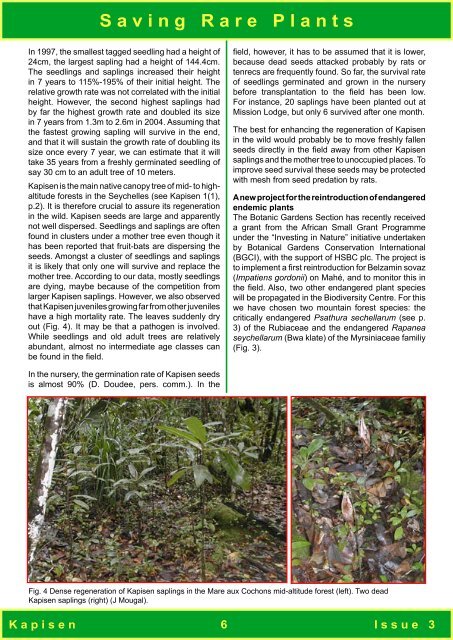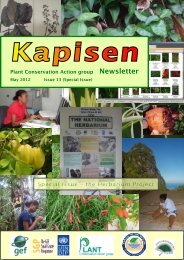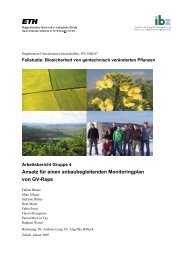Kapisen - ETH Zürich
Kapisen - ETH Zürich
Kapisen - ETH Zürich
Create successful ePaper yourself
Turn your PDF publications into a flip-book with our unique Google optimized e-Paper software.
S a v i n g R a r e P l a n t s<br />
In 1997, the smallest tagged seedling had a height of<br />
24cm, the largest sapling had a height of 144.4cm.<br />
The seedlings and saplings increased their height<br />
in 7 years to 115%-195% of their initial height. The<br />
relative growth rate was not correlated with the initial<br />
height. However, the second highest saplings had<br />
by far the highest growth rate and doubled its size<br />
in 7 years from 1.3m to 2.6m in 2004. Assuming that<br />
the fastest growing sapling will survive in the end,<br />
and that it will sustain the growth rate of doubling its<br />
size once every 7 year, we can estimate that it will<br />
take 35 years from a freshly germinated seedling of<br />
say 30 cm to an adult tree of 10 meters.<br />
<strong>Kapisen</strong> is the main native canopy tree of mid- to highaltitude<br />
forests in the Seychelles (see <strong>Kapisen</strong> 1(1),<br />
p.2). It is therefore crucial to assure its regeneration<br />
in the wild. <strong>Kapisen</strong> seeds are large and apparently<br />
not well dispersed. Seedlings and saplings are often<br />
found in clusters under a mother tree even though it<br />
has been reported that fruit-bats are dispersing the<br />
seeds. Amongst a cluster of seedlings and saplings<br />
it is likely that only one will survive and replace the<br />
mother tree. According to our data, mostly seedlings<br />
are dying, maybe because of the competition from<br />
larger <strong>Kapisen</strong> saplings. However, we also observed<br />
that <strong>Kapisen</strong> juveniles growing far from other juveniles<br />
have a high mortality rate. The leaves suddenly dry<br />
out (Fig. 4). It may be that a pathogen is involved.<br />
While seedlings and old adult trees are relatively<br />
abundant, almost no intermediate age classes can<br />
be found in the field.<br />
In the nursery, the germination rate of <strong>Kapisen</strong> seeds<br />
is almost 90% (D. Doudee, pers. comm.). In the<br />
field, however, it has to be assumed that it is lower,<br />
because dead seeds attacked probably by rats or<br />
tenrecs are frequently found. So far, the survival rate<br />
of seedlings germinated and grown in the nursery<br />
before transplantation to the field has been low.<br />
For instance, 20 saplings have been planted out at<br />
Mission Lodge, but only 6 survived after one month.<br />
The best for enhancing the regeneration of <strong>Kapisen</strong><br />
in the wild would probably be to move freshly fallen<br />
seeds directly in the field away from other <strong>Kapisen</strong><br />
saplings and the mother tree to unoccupied places. To<br />
improve seed survival these seeds may be protected<br />
with mesh from seed predation by rats.<br />
A new project for the reintroduction of endangered<br />
endemic plants<br />
The Botanic Gardens Section has recently received<br />
a grant from the African Small Grant Programme<br />
under the “Investing in Nature” initiative undertaken<br />
by Botanical Gardens Conservation International<br />
(BGCI), with the support of HSBC plc. The project is<br />
to implement a first reintroduction for Belzamin sovaz<br />
(Impatiens gordonii) on Mahé, and to monitor this in<br />
the field. Also, two other endangered plant species<br />
will be propagated in the Biodiversity Centre. For this<br />
we have chosen two mountain forest species: the<br />
critically endangered Psathura sechellarum (see p.<br />
3) of the Rubiaceae and the endangered Rapanea<br />
seychellarum (Bwa klate) of the Myrsiniaceae familiy<br />
(Fig. 3).<br />
Fig. 4 Dense regeneration of <strong>Kapisen</strong> saplings in the Mare aux Cochons mid-altitude forest (left). Two dead<br />
<strong>Kapisen</strong> saplings (right) (J Mougal).<br />
K a p i s e n 6 I s s u e 3







